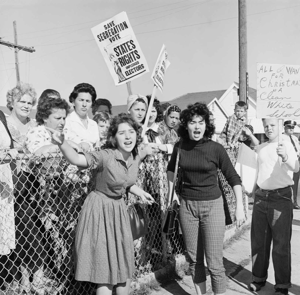Essay

Don’t Assume Black Teachers Matter to Their ‘Nice White Lady’ Colleagues
Union leaders like Greta Callahan claim that the interests of white teachers and families of color are essentially the same. Sometimes this is true. Sometimes it isn’t.
Greta Callahan has a moral dilemma. As the white, progressive president of the Minneapolis Federation of Teachers, it’s her job to protect the interests of her approximately 3,000 members, 72% of whom are white and 75% of whom are women. At the same time, as a teacher and a leader of teachers, it’s also her responsibility to protect the interests of Minneapolis Public Schools’ 29,409 students—60% of whom are kids of color.
These obligations will inevitably come into conflict at times. Sometimes an incompetent, or worse, abusive, teacher needs to be dismissed. Sometimes a student needs educational support their teacher has not been trained to provide.
Historically, union leaders like Callahan have gotten around this dilemma by claiming that the interests of white teachers and families of color are essentially the same. Sometimes this is true. Sometimes it isn’t.
But white, progressive voters—especially moms—have eagerly gone along with this claim because it relieves them of having to make painful choices.
It’s a rationalization that’s becoming harder to pull off in Minneapolis. The district has lost 22% of its enrollment since 2016, including an 11% drop in the last year alone. Our city is on course to sail off the fiscal cliffs within two or three years.
These staggering enrollment losses are being primarily driven by Black families, who leave at three times the rate as white families. Minnesota has open enrollment across public school districts, so Black families are mostly heading to other nearby districts and charters.
And who could blame them? The Minneapolis district’s own data show how poorly children of color are being supported educationally. Only 17% of Black children in MPS read at grade level, compared to a 72% proficiency for white kids. Only 8% of Black children are proficient at math, compared to 61% of white kids. The scores for Hispanic children are similarly low, and they, too, are leaving at far higher rates than white families.
What’s Behind the MFT’s Progressive Image?
Academic inequities have been going on for decades in Minneapolis. When white families were in the overwhelming majority, it was easier to ignore. But children of color now make up 60% of all MPS students. As these families leave for other public alternatives—and take their per-pupil funding with them, Callahan and local leaders face a series of tough choices.
Callahan can stick with the union seniority and teacher placement policies that keep the district centered on the needs of white teachers—and continue losing students of color, who make up the majority of the city’s under-18 population, according to the latest U.S. census data. Or she can try to make the district actually work for students of color—and probably promptly be voted out of union leadership by her members.
For years, families of color have demanded far more teachers of color, more teachers of quality, academic rigor, and a more welcoming culture in the schools.
But any real attempt to make these kinds of systematic changes puts Callahan at odds with her overwhelmingly white, female membership, who do not want to give up seniority protections, rights to bid into schools of their choice, or being forced to change how they teach reading, etc., etc.
Under Callahan’s leadership, the MFT has been admirably outspoken in its support for the Black Lives Matter movement that sprung up in the wake of George Floyd’s murder in 2020. The MFT supported the 2021 progressive attempt to replace the Minneapolis police department with a new department of public safety. In a one-party Democratic stronghold like Minneapolis, the union is seen as a progressive icon.
But when it comes to supporting Black lives inside the classroom, the union has a different and less-progressive record, as Black teachers in Minneapolis discovered during the teachers’ strike last spring.
Black Teachers Forced Callahan to Walk Her Talk
In the negotiations leading up to the strike, the union sent fliers to members saying it was seeking to “support and retain educators of color” by seeking exemptions to layoff rules. Teachers of color, who generally have less time in the system, felt encouraged because the union’s last-in-first-out layoff rules have long caused them to lose their jobs at disproportionate rates when enrollment drops.
Earlier in negotiations, with some fanfare, the union had publicly proposed a specific race-based exemption from seniority lay-offs—a surprising shift from its usual stance against such things. As someone who has watched contract negotiations between the union and the district multiple times, Lynnell saw this as a bold departure from past union practice.
District negotiators welcomed the proposal, but said race-based exemptions would not hold up in court. The district proposed alternate language protecting “under-represented” groups that had been successfully used by other nearby school districts to protect teachers of color—as well as LGBTQ or disabled teachers, etc.
The union responded that these protections were too broad and promptly dropped the matter, leading cynical observers to believe that Callahan’s original offer had been more of a public relations move.
If that’s what it was, it was executed perfectly: the union could appear to be open to protecting teachers of color while knowing the courts would never allow this to actually happen and blaming the district for spurning its offer. The union apparently never informed its members that nearby districts, and unions, using alternate language, had been able to get such lay-off protections.
In February, when teachers voted to authorize a strike, many members believed protection from layoffs for teachers of color was still a bargaining priority. But during the March strike, a group of teachers at Patrick Henry High School, most of whom were Black, noticed that this proposal had suspiciously vanished from the union’s list of demands. After they got no clear response from the union, they launched a petition with 37 signatures to make sure it was back on the table and began visiting other school picket lines to collect more.
In response, Callahan sent out a video to members, warning them of “strike shenanigans.” She told them to be “be careful of who you’re talking to, what you’re signing.” Text messages between strike captains and union members warned that the Henry teachers were “ed reformers…..trying to infiltrate the MFT from within.”
In a video meeting with the Henry teachers, when specifically asked if she was trying to negotiate lay-off protections for teachers of color, Callahan responded: “Our union is not going to get rid of seniority. I want to say that.”
In the end, the Black teachers forced Callahan to shift her stance. Under their organizing pressure, the protections for teachers of color—using the district’s proposed alternative language—were part of the final contract that ended the strike.
But for Black teachers, it didn’t come without cost.
In May, 45 teachers, mostly teachers of color, filed a grievance against Callahan, citing alleged bullying, slander, and intimidation against them because of their successful attempts to get lay-off protection.
In August, a local taxpayer sued the district in an effort to block the seniority exemption for teachers of color. Conservative media jumped all over the story, running headlines like “Minneapolis School District Defends Plan to Lay off White Teachers First” and “Minneapolis Schools to Fire White Teachers First, Regardless of Seniority.” Callahan was all over the media, telling Minnesota Public Radio, “We could not be more proud of this language.”
Black teachers could be forgiven for rolling their eyes.
So what is the takeaway from this local episode about Greta Callahan?
Progressive Must Ask Ourselves: Whose Side Are We On?
For white progressives, it should be a reminder that our public school districts have long been designed to be centered on the needs, comfort, and convenience of white women. It’s in their founding DNA, not constructed with explicit racial terms, but more neutral ones like seniority and teacher placement policies.
It’s also a reminder that liberal institutions, like the teachers’ unions—do not get a free pass because they are full of nice white women with good intentions who look like us, support our politics, and have Black Lives Matter signs in their yards.
In cities like Minneapolis, white women have historically been the biggest supporters of the education status quo, so Callahan’s dilemma is one we all share. Sometimes the needs of white teachers and kids of color are in sync. But when they’re not, whose side are we on? Does it match our lawn signs?

Lynnell Mickelsen is a local education activist and the parent of three (now grown) children who attended Minneapolis public schools.


